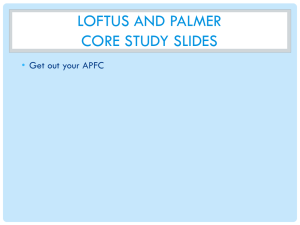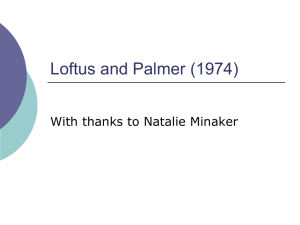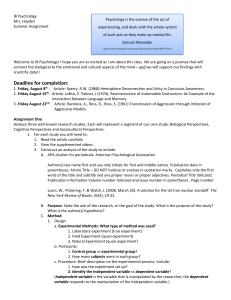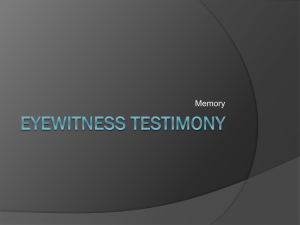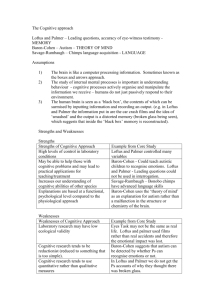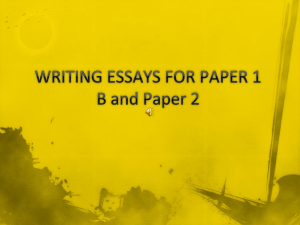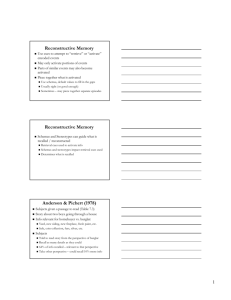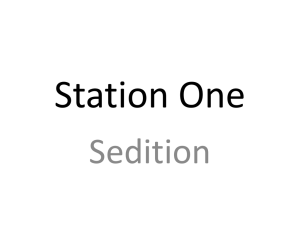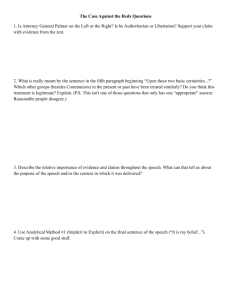loftus and palmer 2015PPH
advertisement
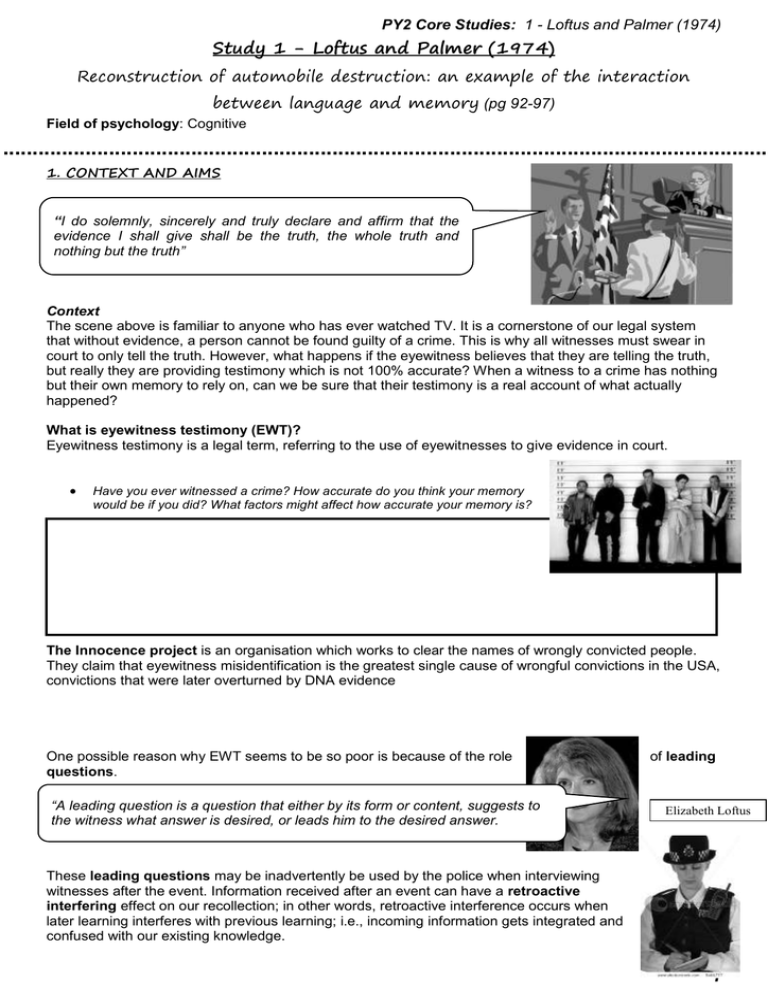
PY2 Core Studies: 1 - Loftus and Palmer (1974) Study 1 - Loftus and Palmer (1974) Reconstruction of automobile destruction: an example of the interaction between language and memory (pg 92-97) Field of psychology: Cognitive 1. CONTEXT AND AIMS “I do solemnly, sincerely and truly declare and affirm that the evidence I shall give shall be the truth, the whole truth and nothing but the truth” Context The scene above is familiar to anyone who has ever watched TV. It is a cornerstone of our legal system that without evidence, a person cannot be found guilty of a crime. This is why all witnesses must swear in court to only tell the truth. However, what happens if the eyewitness believes that they are telling the truth, but really they are providing testimony which is not 100% accurate? When a witness to a crime has nothing but their own memory to rely on, can we be sure that their testimony is a real account of what actually happened? What is eyewitness testimony (EWT)? Eyewitness testimony is a legal term, referring to the use of eyewitnesses to give evidence in court. Have you ever witnessed a crime? How accurate do you think your memory would be if you did? What factors might affect how accurate your memory is? The Innocence project is an organisation which works to clear the names of wrongly convicted people. They claim that eyewitness misidentification is the greatest single cause of wrongful convictions in the USA, convictions that were later overturned by DNA evidence One possible reason why EWT seems to be so poor is because of the role questions. “A leading question is a question that either by its form or content, suggests to the witness what answer is desired, or leads him to the desired answer. of leading Elizabeth Loftus These leading questions may be inadvertently be used by the police when interviewing witnesses after the event. Information received after an event can have a retroactive interfering effect on our recollection; in other words, retroactive interference occurs when later learning interferes with previous learning; i.e., incoming information gets integrated and confused with our existing knowledge. 1 PY2 Core Studies: 1 - Loftus and Palmer (1974) Previous research has suggested that the mind does not work like a camera. Our mind does not just take a picture of what it sees, and then reproduces this memory accurately. Our memories can easily be altered by other information. Summarise Carmichael’s study (1932) on P95 of the text. Explain the procedure, and how it shows that our memories can be altered by new information. Marshall (1969) reports that when Air Force personnel, who knew in advance that they would be asked to estimate the speed of a vehicle, actually observed a car travelling at 12 mph. their estimates ranged from 10 to 50 mph. These results suggest two things: 1: Given that there are such a range of estimates, it suggests that there might be variables which may cause these inaccuracies such as the phrasing of a question to elicit a judgement of speed 2: _____________________________________________________________________________________ _____________ _____________________________________________________________________________________ _____________________________________________________________________________________ ________________________________ It was Filmore (1971) who suggested that the words smashed and hit may imply different rates of speed. These words lead the listener to assume different consequences to the impacts to which they are referring, with hit being perceived as gentler than smashed. Aims Loftus and Palmer’s experiment was actually two experiments. They wanted to investigate in general how accurate or inaccurate memory was. Specifically they wanted to see the effect of _____________________________________ upon estimates of _______________________. Therefore there are two aims to this study. Experiment 1 To see if the speed estimates given by participants upon watching a video of a car crash would be influenced by the wording of the question asked. They wanted to see if participants who were asked a question with the word “hit” in it would give a different estimate of speed than those who were asked the same question but with the word “smashed”. 2 PY2 Core Studies: 1 - Loftus and Palmer (1974) Experiment 2 Loftus and Palmer also wanted to see if the leading questions just changed the responses given to the questions, or whether the participant’s memories had actually altered as a result of the leading questions. Summary Context Definition of EWT The innocence project Leading questions Carmichael (1932) Marshall (1969) Fillmore (1971) Aims To see the effect of leading questions upon the estimates of speed Experiment 1: leading questions and speed estimates Experiment 2: alter memory or just response? 2. PROCEDURES As stated previously, Loftus and Palmer carried out two experiments. You need to know detailed procedures for both of them, as well as participant numbers. Use the information on page 93 and the text on the right (taken from the original article), complete the summary table for experiment 1 and 2 on the next page. Experiment 1 Number and makeup of participants Research method used Laboratory experiment Experimental design Independent measures Independent variable Dependant variable Put the steps of the procedure of experiment 1 into the correct order. After each film, each participant was given a The participants were 45 students questionnaire. The critical question was about the speed of the The second part of the questionnaire was a series of cars specific questions about the film Each participant watched 7 films depicting a traffic All participants were asked the question “How fast were accident. Each film lasted from 5-30 seconds, and the cars going when they ______ each other?” were presented in a different order to each group. The blank was filled with one of the following The first item on the questionnaire was asking the words: hit, smashed, collided, bumped or students to simply give an account of what they had seen. contacted 3 PY2 Core Studies: 1 - Loftus and Palmer (1974) Experiment 2 Number and makeup of participants Research method used Laboratory experiment Experimental design Independent measures Independent variable Dependant variable Summarise the experiment in bullet points Q1: Why were the participants not told about the true aims of the study? Q2: Why were the participants given a series of questions rather than just the critical question alone? Q3: What was the point of having a control group in the second experiment? 4 PY2 Core Studies: 1 - Loftus and Palmer (1974) 3. FINDINGS AND CONCLUSIONS Experiment 1 Findings A Average estimate of speed for the four videos (all participants) Actual speed of car crash Mean speed estimate (mph) 20 37.7 30 36.2 40 39.7 40 36.1 B Average speed given for the different verbs used Verb used in critical question Mean speed estimate (mph) Smashed 40.5 Collided 39.3 Bumped 38.1 Hit 34.0 Contacted 31.8 Conclusions What can we conclude from table A? What can we conclude from table B? Explain how the results above support the theory of the effect of leading questions Loftus and Palmer give two alternate explanations of the results. It may be that the participant’s response is biased, in other words they are uncertain whether to say 30mph or 40mph, and the verb smashed biases their response. Alternatively, the verb used in the question may actually causes a change in the participant’s memory such that they see the accident as being more severe than it really was. 5 PY2 Core Studies: 1 - Loftus and Palmer (1974) Experiment 2 Findings A Average estimate of speed for the two verbs Verb Used in critical question Mean speed estimate (mph) Hit 10.46 Smashed 8.00 B No of ppts who claimed to see broken glass Condition Hit Yes 7 Smashed 16 Control 6 No 43 34 44 C – Probability of saying yes to the broken glass question for different speed estimates Condition 1-5 Hit .09 6-10 0.27 11-15 0.41 16-20 0.62 Smashed .09 0.25 0.50 .06 What can we conclude from table A What can we conclude from table B What can we conclude from table C 6 PY2 Core Studies: 1 - Loftus and Palmer (1974) Conclusions In experiment 1, Loftus and Palmer gave two alternate explanations of the results (biased response and altered memory). Which explanation do the results of experiment 2 support? Loftus and Palmer suggest that memory is made up of two types of information. What are these and how do they combine to make a memory? There is what actually happened, what was observed, and then there is information gained after the event. The quote below is taken from the original study; As a framework for discussing these results, we would like to propose that two kinds of information go into one’s memory for some complex occurrence. The first is information gleaned during the perception of the original event; the second is external information supplied after the fact. Over time, information from these two sources may be integrated in such a way that we are unable to tell from which source some specific detail is recalled. All we have is one “memory.” Apply the above to explain the results of this experiment. Summary Experiment 1: Finding: the average speed given by participants was roughly the same across all 4 films Conclusion: humans are generally bad at estimating speed Finding: the participants gave a higher speed estimate with the verb smashed than the word contacted Conclusion: the verb used can affect the estimate of speed, with the more aggressive verbs being associated with higher speeds. Overall conclusion from experiment 1: the verb used in a question can act as a leading question, and lead participants to give different estimates of speed. However, we do not know from experiment 1 if this difference was due to a biased response, or an altered memory. Experiment 2: Finding: the average speed given for the word smashed was higher than the average speed for the word hit Conclusion: like in experiment 1, the verb used has an effect on estimates of speed Finding: participants asked the smashed question reported seeing more broken glass than those asked the hit question, or those not asked about speed. Conclusion: the leading question has also led the participant to remember features of the car crash that were not there. The leading question had altered their memory rather than just bias their response. Finding: the faster the participants estimated the cars were travelling, the more likely they were to report seeing broken glass Conclusion: the estimates of speed given by the participants altered their memory, with higher speed being associated with the presence of broken glass. 7 PY2 Core Studies: 1 - Loftus and Palmer (1974) Overall Conclusions Memory is made up of two types of information: what was actually perceived, and information received after the event. Memory is therefore reconstructed from both sources of information, and therefore may be unreliable. 4. EVALUATING THE METHODOLOGY (pg 96) Method: The methodology used in this study was a lab experiment. What was a strength of using this methodology is this study? ________________________________________________________________________________ _____________________________________________________________________________ ______________________________________________________________________________ ______________________________________________________________________________ ______________________________________________________________________________ Reliability: This study has been replicated many times, and similar findings have been produced. What does this suggest about the reliability of the study? _____________________________________________________________________________________ _____________________________________________________________________________________ _____________________________________________________________________________________ _____________________________________________________________________________________ ____________________________________ Validity: What aspects of the study affect the ecological validity? The setting: _____________________________________________________________________________________ _____________________________________________________________________________________ _____________________________________________________________________________________ _____________________________________________________________________________________ _ The participants watched a video of a car crash, not a real car crash: _____________________________________________________________________________________ _____________________________________________________________________________________ _____________________________________________________________________________________ _____________________________________________________________________________________ _____________________________________________________________________________________ The participants were aware that they were in a study: __________________________________ ____________________________________________________________________________________ _____________________________________________________________________________________ _____________________________________________________________________________________ ________________________ 8 PY2 Core Studies: 1 - Loftus and Palmer (1974) Sampling: The sample consisted of US college students. Could there be issues with generalisability? In what way are these participants different from the target population (all people)? _______________________________________________________________________________ _______________________________________________________________________________ _______________________________________________________________________________ ________________________________________ Ethical issues: Can you see any ethical issues with this study? ______________________________________________________________________ ______________________________________________________________________ ______________________________________________________________________ ______________________________________________________________________ ______________________________________________________________________ __________________________________________________________________________________ ________ 9 PY2 Core Studies: 1 - Loftus and Palmer (1974) 5. CRITICALLY ASSESS WITH REFERENCE TO ALTERNATIVE EVIDENCE Match the study to the conclusion 1: Loftus and Zanni (1975) Showed participants a film of a car accident. Some participants were asked “Did you see a broken headlight?” whereas others were asked “Did you see the broken headlight?” 7% of those asked about a broken headlight reported seeing one, whereas 17% asked about the headlight reported one. (There was not one in the video) A: This research contradicts Loftus and Palmer, as it suggests that in some circumstances, leading questions have a limited effect on memory. It may be that the information to be remembered in this study was less subjective than estimating speed. 2: Loftus (1979) Showed participants a series of pictures of a man stealing a red wallet from a woman’s bag. 98% of participants were able to identify the colour correctly. Later, Loftus used leading questions to try and alter the participants recall. However, they persisted in describing the purse as red. B: This study develops the research into EWT. Whereas Loftus and Palmer investigated the effect of leading questions in altering memories of real events, this research suggests that leading questions can even plan memories that were never there. It develops the theory that verbal information can alter memory. 3:Buckhout (1980) A 13 second film clip of a mugging was shown on TV. An identity parade of six suspects was later shown and viewers asked to phone in and say who they thought had done it. Given that there were only six suspects, chance alone would suggest that 17% would get it right. In fact only 14% identified the person correctly. 4:Yullie and Cutshall (1986) Interviewed 13 people who had witnessed an armed robbery in Canada four months after. They included two misleading questions. They found that the participants were not led by the leading questions, and the accounts that they gave were very similar to those in their initial witness statements 5: Loftus and Pickrell (1995) Interviewed participants about events in childhood, planting a false memory of being lost in a mall as a child (an event that never happened). 20% of the participants came to believe that this event had actually happened, and some even clung to the memory after being debriefed. 6: Braun et al (2002) Participants who had visited Disneyland as a child were told that they would be evaluating advertisements for it. Group one were given an ad with no characters on it, group two were given the same ad with a cardboard Bugs Bunny in the corner of the room; group three were given an ad that had bugs bunny on it, and the group four got the Bugs Bunny ad and the cardboard Bugs Bunny. When asked later about having met Bugs Bunny as a child, 30% of group 2 and 40% of group 4 recalled meeting him. (Bugs Bunny is not Disney, so this was a false memory) 1 2 3 C: A criticism of Loftus and Palmer was that the participants knew that they were in a study, and so their behaviour may have been unnatural. This study gets around this issue by demonstrating that recall in real life, when participants do not know that they will be asked to recall is still very poor. D: This study has the advantage of letting us see the effect of leading questions on real life eyewitnesses. It suggests that the results of Loftus and Palmer only apply in a laboratory setting, not in real life cases. It supports the argument that Loftus and Palmer’s research lacks ecological validity. E: A criticism of Loftus and Palmer’s experiment is that judging speed is complex, and therefore the participants more prone to being led by leading questions. This research however demonstrates that leading questions can actually cause participants to remember something that was not there. This supports Loftus and Palmer, as it provides more evidence that leading questions can alter the response given. F: This research build upon the results of Loftus and Palmer, as it suggests that misinformation does not need to be verbal for it to have an effect on recall. False memories can be established by non verbal/visual information. 4 5 6 Use three colours to highlight research that supports, contradicts, or develops Loftus and Palmer’s research. 10
